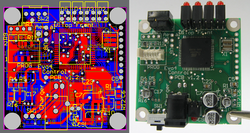You just got a nice big PCB back from the fab shop. You set one on your desk to admire only to discover that it’s warped. What do you do?
There are two primary types of causes of board warping: process related at the fab or assembly shop, and layout-related issues. If it’s warped before assembly, it’s between fab and layout. If it’s flat before assembly and warped, after, it’s most likely between layout and assembly — although sometimes a fab problem won’t show up until a pass through the reflow oven at your assembly partner.
Determining the root cause is generally a bit of an iterative process. It’s tempting to start right off with your fab or assembly partner, but you need some information before giving them a call. You’ll need such things as the amount of warpage per inch, board size and thickness. With that, you need to take a good look at your design and consider copper pours, component size and component placement.
With that information in hand you can make your phone call. If the board is warped before assembly, call your fab shop. If it’s flat pre-assembly and warped post-assembly, call your assembly house.
The shop you call will want to talk over your design to help you pinpoint the cause. If you can rule out a design issue,then you need to talk with your partner to determine whether it’s a fab or assembly issue and next steps to take care of you.
Here are a few design issues that could contribute to warping:
- Uneven copper pour. Copper and FR-4 are a good match relative to thermal expansion, but they aren’t exact. A large pour on one side or corner of your board can lead to warping due to dissimilar expansion characteristics. This could cause warpage either at the fab shop or the assembly house.
- Components with large thermal mass grouped together on the board. This would be more likely to cause problems during assembly than during fab. The thermal mass will act as a heat sink for that area on the board, which can lead to uneven expansion and uneven soldering.
- A board that’s too thin for the size or number of components could lead to warping at any stage.
- Odd shapes or large cutouts could also lead to warping at any point.
There may be other, more obscure causes, but those are the main design related causes. If it’s none of those talk with your partner.
Occasionally, design requirements lead to a board that is essentially non-manufacturable. Hopefully you never have this situation, but if you do, make sure that thickness, component location, pours, or cut outs really, really, really, need to be the way they are.
If you absolutely, positively can’t change anything, go back and try again. Then you can to look for heroic means to get the board fabbed and built.
Slight warpage might go away when the board is mounted. Just be careful with that. Some components may not stay securely soldered when you flatten it.
The board may need a special fixture during assembly to prevent warping. This will likely cost extra, but if you can’t change your design, and still need it built, it may be your best option.
Finally, if nothing works, you may need to look harder at the design, or look for a new fab or assembly house. We all like to think we can do just about anything, but every shop has its limits, and on rare occasion those limits can be difficult to spot.
Duane Benson
What if Godot was late because he was waiting for John Galt?

 Based on interviews with the coordinator of the IPC-2221, a different tack was taken, which slowed the process considerably. It took the task group several years before calling a hard stop. Another difference is the decision to include a fair amount of tutorial in the design standard, whereas the soldering task group stripped all that info out years ago, opting instead to segment it into a separate handbook.
Based on interviews with the coordinator of the IPC-2221, a different tack was taken, which slowed the process considerably. It took the task group several years before calling a hard stop. Another difference is the decision to include a fair amount of tutorial in the design standard, whereas the soldering task group stripped all that info out years ago, opting instead to segment it into a separate handbook.